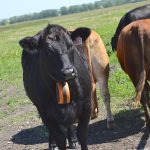LINDELL BEACH, B.C. — Poor farmers in East Africa have traditionally used the leaves from a woody shrub to control fevers.
They have now found that they can also help their cattle cope with ticks by soaking and pulping those leaves to produce an extract that they can spray on their livestock.
Biting insects can transmit blood parasites and cause irritating wounds that lead to infection.
Fever tea, also known as lemon bush, is a perennial plant that stands one to two metres high and is widespread throughout South Africa with the exception of the Western Cape and grows northward into Botswana, Swaziland, Mozambique, Malawi, Tanzania, Zambia, Kenya and Zimbabwe.
Read Also

Trump cuts off trade talks with Canada
(Reuters) – U.S. President Donald Trump said on Thursday that all trade talks with Canada were terminated following what he…
It grows in open veld and the bush and along forest margins. The leaves are hairy and smell of lemons when crushed, making it among the more aromatic indigenous plants in South Africa.
Its flowers are small and white, blooming in dense flower heads.
It is the leaves that are the most valuable to people with livestock. African producers with bigger herds control ticks, mites and flies by dipping their cattle in a commercial pesticide but this is impractical and expensive for poorer farmers with just a small number of livestock.
Now, with some help from science, they can look to the fever tea shrub for a natural solution.
A team from Great Britain’s University of Greenwich, working in collaboration with the University of Zimbabwe, pulped and soaked the fever tea leaves in water to produce an extract that could be sprayed on cattle.
The goal was to find safer alternatives to synthetic pesticides and reduce field crop damage, stored product losses and livestock illness or mortality.
Researchers experimented with varying concentrations to discover which would be the most effective application method and offer the best level of protection against bites.
“The material (plant) was reportedly used by farmers in a particular way and at a vague concentration so we had an idea of the range of concentrations to test,” said Phil Stevenson, head of chemical ecology in the University of Greenwich’s agriculture, health and environment department.
“We are primarily interested in validating materials that can then be promoted widely to offer small holders and poor farmers a sustainable and environmentally benign alternative to expensive and toxic pesticides.
It is already used as a green tea to reduce the symptoms of fever although, like almost anything, if consumed at very high concentrations, it can cause problems.”
Fever tea, formally known as Lippia javanica, occurs as two subspecies, L. javanica and L. whiteii.
The chemistry differs between the two but most people would not be able to tell them apart easily.
“The differences in their chemistry are something we are working on right now,” said Stevenson.
“When used at the correct dosage, Lippia javanica proved to be almost as effective as the industrial pesticides used for tick control.”
He said researchers haven’t been able to identify the active ingredients that make it work as a pesticide, but most are probably essential oils.
“We are working on this at the moment, looking at the water soluble chemicals,” he said.
“We did this thinking that since the extract was made in water, then the compounds must be water soluble. However, in reality the essential oils will be in the water extract used to treat cattle.”
Stevenson said the plant flowers almost continuously, which makes it difficult to separate the flower from the leaves.
The essential oils are found in the flowers and leaves but not in the root and stems.
The shrub’s leaves can be easily harvested from abundant bushes in the wild and readily grown from seed. Farmers require only the time it takes to harvest and prepare the Lippia extract as opposed to buying expensive, commercial synthetic pesticides.
Further research is continuing into how best to extract the active ingredients and how to apply them to the lower parts of cattle, where the ticks attach themselves.
The plant extracts appear to have no side effects on people or animals, and the solution lasts only as long as it takes to clear the animal of ticks. One rain will wash it off.
The work is part of the African Dryland Alliance for Pesticidal Plant Technologies (ADAPPT) project, which is funded by the European Union and led by the University of Greenwich.
Partners include the Royal Botanic Gardens, Kew, and non-government organizations, agricultural institutes, ministries, and universities from eight African countries.
Stevenson said the focus of the study is to validate and promote a locally sustainable practice for poor farmers, but production of the shrub as a commercial venture could face challenges.
“The cost of registration is likely to make this uneconomical,” said Stevenson.
“It’s a perennial problem in developing plant-based pesticides. As a herbal remedy, no problem, since the regulations governing the production, sale and distribution of plants for medicinal use that a herbalist recommends you put directly into your mouth are pretty relaxed,” he said. “However, a material described as a pesticide that could potentially kill people, animals and insects therefore has to undergo the same process as synthetic chemicals.
It is made all the more complicated by the number of chemicals in the plant.”
Stevenson said a patent has been filed in the United States to develop the essential oils as a possible application for people.














